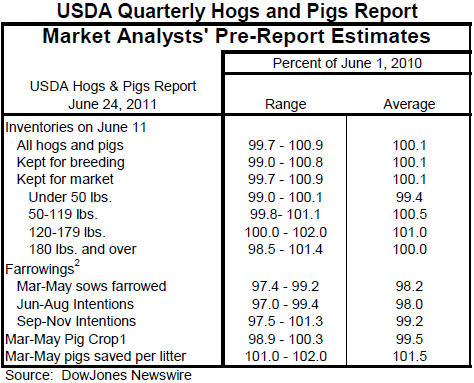



CME: Companies Reduce Broiler Hatchery Flock
US - Over 40,000 weekly corn, soybean and wheat options contracts have been traded since their launch on 23 May, write Steve Meyer and Len Steiner.That includes over 7,000 contracts the day before the 9 June USDA Crop Production report — just the sort of potentially high-impact event that these short-term weekly options are designed to address.
DowJones Newswires released results of its pre-report survey of analysts regarding their expectations of key numbers in Friday’s USDA quarterly Hogs and Pigs report. The results appear in the table below.

It appears that “Steady as she goes” is the expected watchword for the US pork industry as most of the average estimates are very near 100 per cent of year-ago levels. The only exceptions are March- May farrowings and June-August farrowing intentions which are near 2 per cent lower than last year in spite of a breeding herd that is expected to be marginally larger. That would follow the pattern set in USDA’s March Hogs and Pigs report but defies anecdotal evidence that productivity rates in US farrowing units are still very high.
An aside on sow herd productivity: One of the reasons for rising litter sizes is the price of cull sows. High cull sow prices have made selling an older animal far less painful that it once was. In fact, for most of the past three years, producers could replace a cull sow with a new gilt for the amount of money received for the sow — and usually put up to $100 in the bank as well. That kind of economic benefit has encouraged producers to roll sow herds more quickly thus getting access to rapidly improving reproductive genetics being offered by today’s prolific sow lines. While keeping sows through litters 3, 4 and 5 of their productive lives is still best since those are usually the sows largest litters, keeping them beyond litter 5 may not be optimal due to the rate at which female lines are improving and the high salvage values that have been garnered by cull sows.
US chicken companies reduced the broiler hatchery flock by 1 per cent during May. USDA reported in its monthly Chicken and Eggs report that the hatcher flock numbered 54.79 million birds on 1 June. That compares to 55.309 million birds on 1 May and 55.237 million birds on 1 June 2010. The year-over-year reduction amounts to 0.8 per cent. The 1 June flock is 4.3 per cent larger than it was at its most recent lowest level (52.529 million) on 1 October 2009.

While the May reduction is very normal from a seasonality viewpoint, the industry is showing signs of reducing output and symptoms of not reducing it earlier. Atlanta-based Cagle’s announced today that it would cut a shift at its Pine Mountain Valley, Georgia plant, laying off 300 workers and reducing throughput at the plant from 520,000 to 320,000 birds per week. Broiler egg sets have been below year-ago levels for 5 weeks straight, averaging 2.1 per cent fewer, year-on-year, since 8 May.









